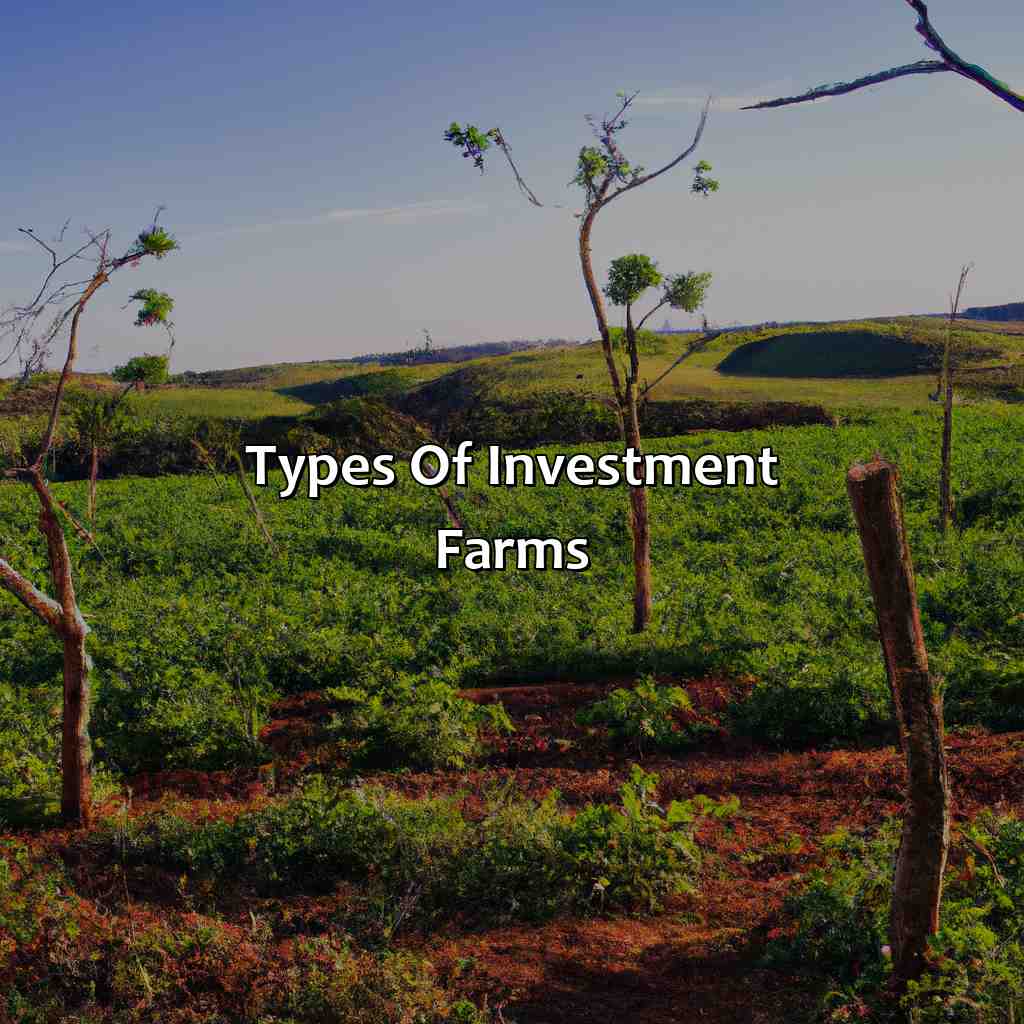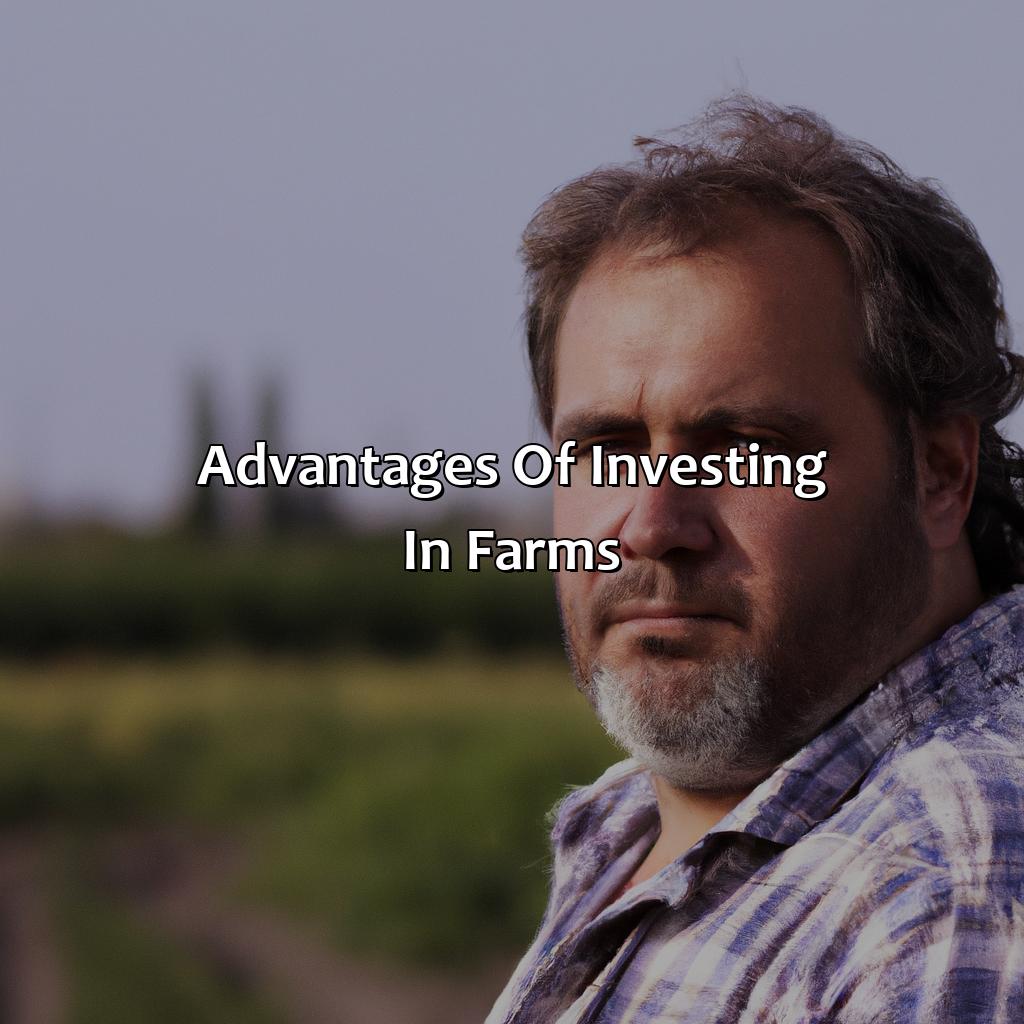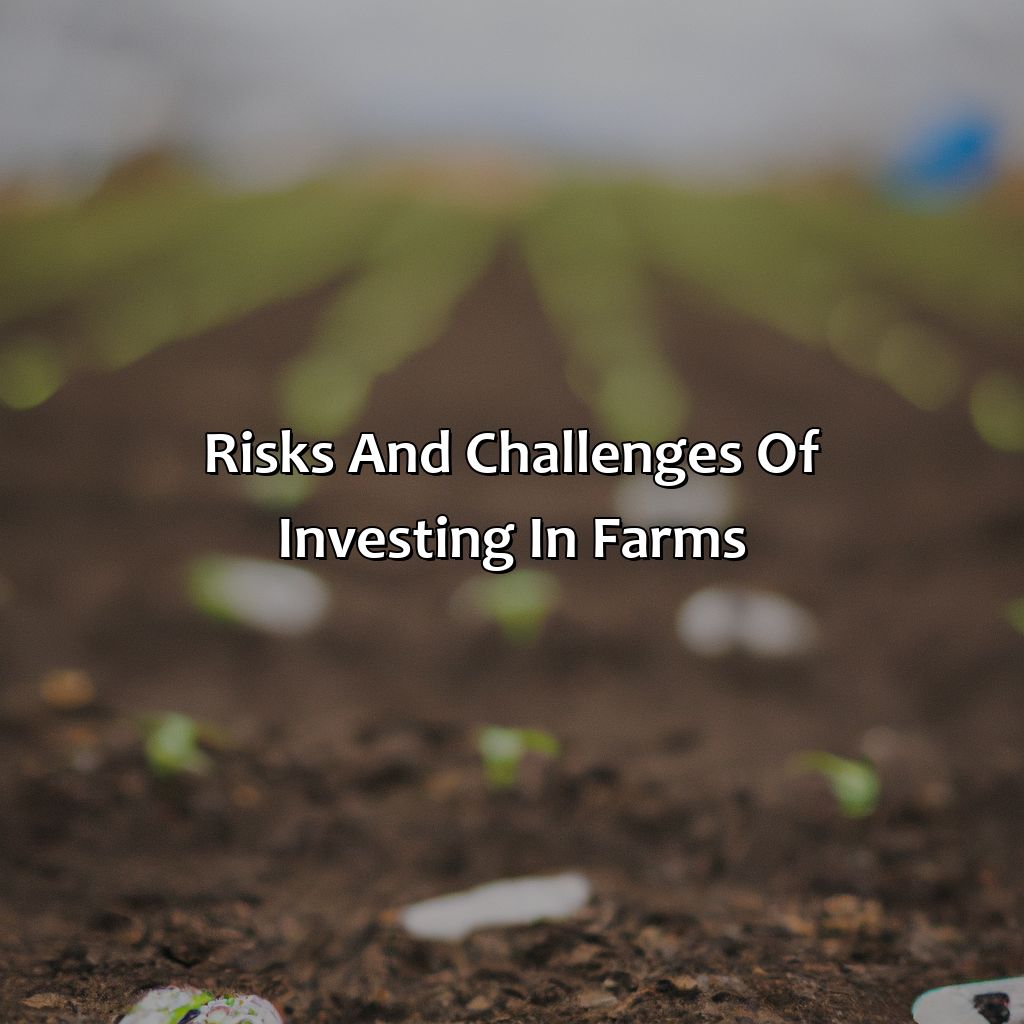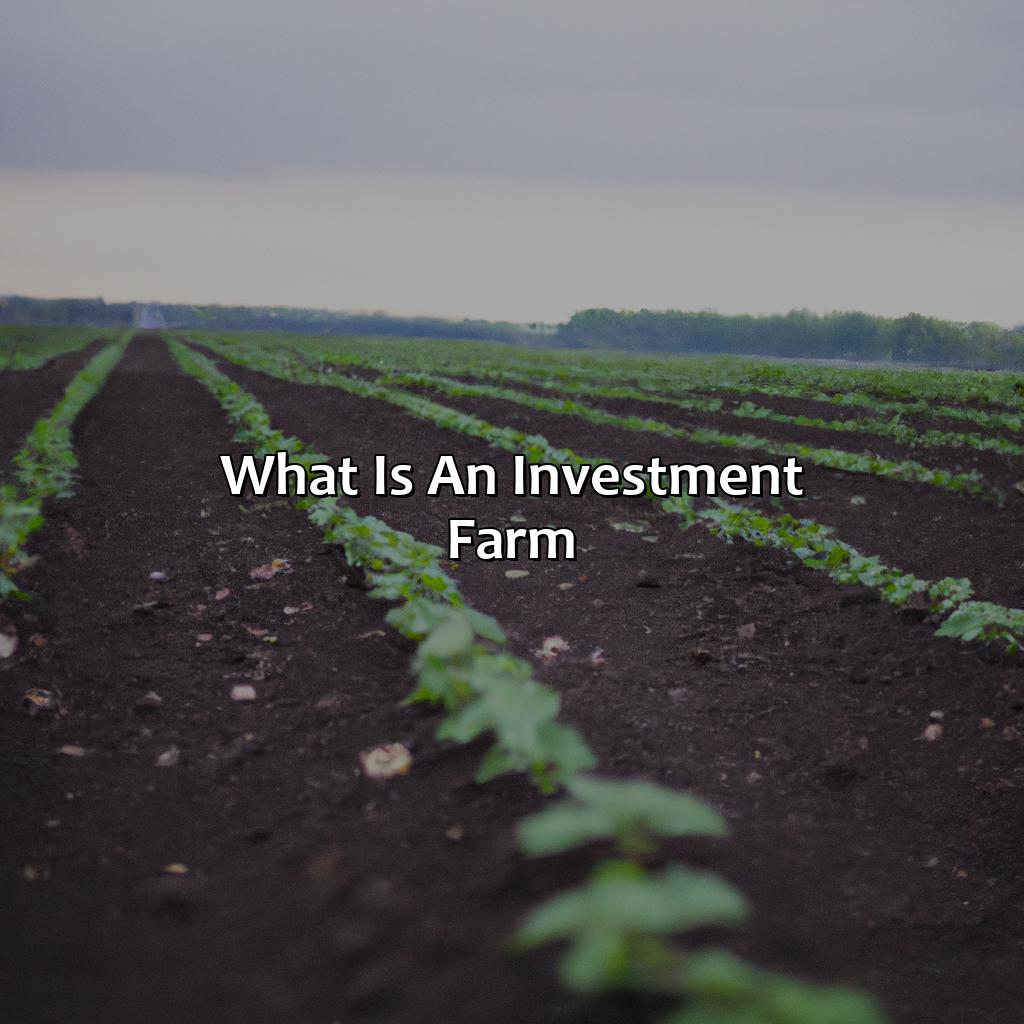What Is An Investment Farm?
Key Takeaway:
- Investment farming involves purchasing farmland with the purpose of generating income and capital appreciation. The purpose of investment farming is to generate returns on investment by using the land to produce crops, livestock, fisheries, or forestry products.
- Investment farming can be a great way to diversify your investment portfolio and provide steady returns. In addition to high returns, investing in sustainable agriculture can also have positive environmental and social impacts.
- However, investing in farms also comes with risks and challenges, such as market volatility, crop and livestock diseases, weather conditions, and high initial investment. It is important to carefully consider these factors and conduct thorough research before investing in a farm.
Are you looking to make the best financial decisions? Investing in an investment farm can ensure that you are getting the most from your money. Learn how an investment farm can help you secure your financial future.
Definition and Purpose of Investment Farming
Investment farming involves purchasing and cultivating agricultural land for profit. The primary purpose is to generate returns through the sale of crops, livestock or land appreciation. By investing in agricultural land, investors can benefit from natural resources like rainfall and fertile soil that contribute to increased crop yields and appreciating land values over time. Investment farming is becoming a popular alternative investment for individuals looking to diversify their portfolio.
Investment farming presents several benefits for investors, including long-term capital appreciation, hedge against inflation, tax benefits, low volatility as compared to other investments like stocks and bonds. The revenue generated from the sale of crops or livestock can be used for reinvestment in the farm or other opportunities. Furthermore, investing in sustainable agriculture can help promote ethical food production practices while supporting local farmers.
It’s important to consider factors such as government regulations, environmental concerns and potential hazards before investing in agricultural land. Getting professional assistance in conducting due diligence when purchasing farmland could mitigate risks with regards to zoning laws ownership transparency issues.
Don’t miss out on the opportunity to diversify your portfolio with investment farming today! With low volatility and high potential returns, it’s a smart way to grow your wealth sustainably while supporting ethical agricultural practices. Making money off the land has never been so satisfying, especially when your investment farm doubles as a zombie apocalypse survival plan.
Importance of Investment Farming
Investment farming plays a critical role in the modern economy by generating stable revenue streams for investors. It is a strategic and innovative method of investing that allows potential investors to own farm properties, participate in production cycles and earn substantial returns on their investment. The significance of investment farming lies in its ability to deliver double-digit returns while actively contributing to food security and sustainable farming practices.
By leveraging the expertise of successful farm managers, investors can benefit from high-yield food crop yields or enjoy passive income streams without assuming significant operational risks. Furthermore, the diversification benefits offered by investment farming mitigate portfolio risk levels while delivering steady outperformance against other major asset classes.
Several unique methods have also emerged for interested individuals to get involved with small landholders or invest directly in agribusinesses without massive capital expenditure requirements. By tapping into various government subsidies and leveraging technology in agriculture, value-added opportunities are emerging across several niche sub-sectors such as organic foods and specialty crops.
A Japanese cucumber farmer, Masanobu Fukuoka’s approach consisted of minimal intervention with natural processes, challenging traditional normative industrialized agriculture methodologies; he established no-till and no-irrigation systems among other methods towards natural abundance. This made his farms self-sufficient enough not to require any input for several years avoiding soil erosion while reducing carbon footprints. Investment farming must align with sustainable agricultural practices to meet global demands while benefiting stakeholders at the same time.
Do you like your investments like you like your farms? Well diversified and profitable. Welcome to the world of investment farming!
Types of Investment Farms
Want to know more about the various types of investment farms? They include crop farms, livestock farms, fisheries, and forestry. To get a better understanding of investment agriculture, you have to explore the four distinct sub-sections. Each offers a unique outlook on investing in agricultural operations.

Image credits: retiregenz.com by Harry Washington
Crop Farms
Investment farms that cultivate crops bear unique characteristics compared to other types of investment farms. These farms grow various crops such as fruits, vegetables, grains, feed, and other plants specifically for profit and long-term returns. Crop farming is a profitable and popular method of investing in agricultural land and business operations.
The return on investment depends on the type of crop grown, market demand, weather conditions, labor availability and costs with estimated yield potential. Crop production is influenced by factors like climate change which affect the amount and quality of produce leading farmers to adapt to better measures. Long-term crop rotation practices are fundamental for maintaining soil fertility and productivity. Investment in mechanization to increase efficiency has been observed in recent years as well as focusing on ways to reduce water usage.
Crop farms have evolved dramatically since the development of hybrid seed varieties. In many regions around the world, private investors own large-scale cropland investments alongside smallholding individual farmers or farmer cooperatives making it a thriving industry sector with global reach.
There are numerous examples throughout history where crop farming revolutionized local economies through increased output providing supply sustainability beyond their borders while large plantations catering worldwide impacted markets by changing consumption patterns under colonial-era capitalism.
Why buy a cow when you can invest in a whole herd? Welcome to the world of livestock investment farms.
Livestock Farms
An investment farm that specializes in raising domestic animals for various purposes is called a Vertebrate Farms. These farms not only provide a steady income stream but also help meet the ever-growing needs of human consumption.
Vertebrate Farms can raise various species of animals, depending on market demand and personal interest. Livestock Farms specialize in breeding and rearing large mammals for meat production. This type of farm includes cows, pigs, sheep, and goats.
Investors in Livestock Farms can choose to specialize in one type or create a mixed farm to cater to multiple target audiences. A profitable strategy in recent years has been offering organic meats from free-range livestock.
Keeping abreast of the latest scientific research on animal husbandry is crucial for success. By adopting best agricultural practices, ensures animal welfare is taken care of while ensuring quality products are produced.
Pro Tip: Undertaking due diligence thoroughly before investing in such farms is recommended; investigating market forecasts about several species you are interested in will help make informed decisions.
Why buy fish at the market when you can invest in a fishery and have a lifetime supply of sushi?
Fisheries
Saltwater Farming
Saltwater farming, commonly known as Fisheries, is a type of investment farm that involves breeding fish, crustaceans and other aquatic animals for food. This farming practice includes hatcheries, nursery ponds, and grow-out ponds. It is popular among investors due to its high demand for seafood and relatively low operating costs.
An example of a typical Fisheries table would include the following columns: species of fish, location of the farm, quantity produced per year, market price per unit and total revenue. For instance, Atlantic salmon can be farmed in Tasmania which yields a production rate of 20 tons per year with a market price of $14 per kg thus resulting in total revenue of $280k.
Additionally, fisheries may also involve environmental considerations like water quality and disease prevention measures. Farms located near areas with high levels of pollutants may have to incur additional costs concerning water treatment to maintain the ideal environment for fish growth.
Pro Tip: Before investing in fisheries, consider factors such as local regulations on fishing practices and environmental impact assessments.
Why buy lumber at Home Depot when you can invest in a forestry farm and have your own personal supply of logs for all your DIY needs?
Forestry
Exploration and Insight into Investment Farming.
Investment in Forestry involves acquiring pieces of land solely for the purpose of growing trees, which are harvested for timber. Investors earn a return on their investment by either selling the trees for timber or by selling the land once the trees have reached maturity.
A table showcasing various features and facts about forestry investment would be useful to potential investors. It would include columns such as location, cost/acre, IRR (Internal rate of return), age of trees at harvest, harvest period, tax benefits, and demand/supply prospects.
When making an investment decision regarding Forestry farm management, it is important to know that there are three distinct types. Unmanaged plantations rarely receive any attention after planting. A more improved form of this option is a semi-managed plantation where minimal tree care such as pruning occurs before harvesting. Lastly, a fully managed plantation undergoes full hands-on maintenance throughout its life cycle.
One example of smart investment within forestry farming took place when Mitsui & Co invested $62 million in joint enterprise with New Forests Ltd., an Australian forest asset management company producing high-grade eucalyptus pulpwood primarily targeting Thai plywood manufacturers – this ultimately yielded high profits.
Investing in farms means you can finally tell everyone you’re a farmer, without actually having to do any farming.
Advantages of Investing in Farms
Want to know the perks of investing in farms? Then keep reading. We’ll cover:
- High revenues
- Diversifying your investments
- Tax advantages
- Green agriculture
All these are great reasons to check out farm investments!

Image credits: retiregenz.com by Harry Washington
High Returns
The Investment Farms offer lucrative returns on investment, making it an attractive option. This is achieved through the combination of a diverse and sustainable approach in farming practices with proper management to ensure high rewards in the long run. The farming activities are well planned, cost-efficient, and executed efficiently, leading to increased yields that translate into substantial profits for investors.
Investment in farms provides an opportunity to diversify one’s investment portfolio while enjoying high returns. It stands out as a low-risk investment as opposed to other options like stocks or real estate. This is because farmland retains its value over time, and even when the market fluctuates, there will always be demand for agricultural produce. Furthermore, the return on investment from farms can be enhanced by investing in cutting-edge technology that increases productivity.
Investment in agriculture also contributes to food security and environmental protection. Additionally, many countries offer tax incentives for investing in farms due to their positive impact on national development goals.
Investors can make the most of investments in farms by partnering with experienced farmers who have a proven track record. They can also choose different farming types such as agroforestry or organic farming that provide higher yields than traditional methods.
Don’t put all your eggs in one portfolio, diversification is key – unless you’re investing in a chicken farm.
Diversification of Investment Portfolio
Investing in farms is an excellent strategy to diversify your portfolio. By allocating a portion of your resources into farmland, you can hedge against inflation and market fluctuations. This type of investment is reliable and offers long-term returns while being less volatile than other assets. Additionally, investing in farms helps protect wealth during financial crises as farmland has inherent value and low liquidity risk.
Furthermore, farmland investments provide investors with unique tax benefits such as depreciation allowances and favorable capital gains treatment. Investing in farm-based companies or real estate investment trusts (REITs) offer additional benefits such as higher liquidity and diversification within the farming industry. By investing a portion of your portfolio in these options, you can achieve greater diversification while reaping substantial returns.
Agricultural land investment also provides a host of social and environmental benefits alongside economic advantages. By investing in sustainable farming practices, investors stimulate rural economies while mitigating greenhouse gas emissions. The returns on farmland investments are not limited to financial incentives alone but instead extend to solutions for environmental issues, food security, and cultural preservation.
Pro Tip: It’s advisable for potential investors to conduct thorough research before investing in any agricultural project or company to make informed decisions based on complete knowledge of the sector’s dynamics.
Want to save on taxes? Invest in a farm and reap the benefits – both in your wallet and in your belly.
Tax Benefits
The investment in farms offers various tax-related advantages. These advantages include tax deductions for expenses related to the farm, tax credits on renewable energy projects, reduced capital gains tax when selling farmland and more. By investing in a farm, an individual can minimize their overall tax liability while also supporting agriculture.
Moreover, one of the significant benefits of investing in farms is the opportunity to generate additional income through lease agreements or farming operations. Investors can earn rental income from leasing out their farmland to farmers or undertake farming operations themselves and sell produce at higher margins. Investing in farms may also provide long-term stable returns due to low volatility and strong demand for agricultural products.
Pro Tip: Always consult with a financial advisor or accountant before investing in a farm, especially when it comes to tax-related matters. They can guide you on how to structure your investment and minimize your tax liability effectively.
Put some green in your pocket and the planet’s too by investing in sustainable agriculture!
Investing in Sustainable Agriculture
Sustainable agriculture investments bring long-term benefits to investors by promoting food security and environmental conservation. By diversifying their portfolio with investment farms, investors can expect stable returns while supporting global sustainability efforts. Furthermore, investment farms incorporate ethical farming practices that benefit both farmers and consumers alike.
These investment opportunities not only provide financial returns but also offer a chance to contribute to sustainable development goals by supporting rural communities and preserving biodiversity. Investing in sustainable agriculture also promotes sustainable land use practices that are critical for the long-term survival of our planet.
Investment farms have proven to be a reliable source of return as they mitigate market fluctuations while offering wider social benefits. The United Nations declared 2021–2030 as the Decade of Ecosystem Restoration, emphasizing the need for investors to direct their capital towards solutions targeting climate change; investing in sustainable agriculture is one such solution.
According to the World Economic Forum, an estimated 80% of tropical deforestation is caused primarily by agribusiness, highlighting the potential impact of this sector on environmental degradation. Investing in sustainable agriculture provides an opportunity for investors to tackle this issue while contributing positively to society.
(Source: World Economic Forum)
Why go bungee jumping when you can invest in a farm and experience the same amount of ups and downs?
Risks and Challenges of Investing in Farms
Gain knowledge about the risks and challenges of investing in farms. “What is an investment farm?” Learn potential obstacles before investing:
- Market Volatility
- Crop and Livestock Diseases
- Weather Conditions
- Natural Disasters
- High Initial Investment
All are essential to consider to make informed decisions.

Image credits: retiregenz.com by Joel Jones
Market Volatility
The unpredictable nature of the agricultural industry can cause instability in farm investments, leading to market fluctuations. Such volatilities have a direct impact on the supply and demand for crops and livestock, ultimately impacting profitability. Additionally, external factors such as natural disasters or political unrest can further increase volatility, making it crucial for investors to stay informed and adapt their strategies.
Investors must thoroughly assess market conditions before investing in farms to minimize risks associated with market volatility. This includes researching historical trends and analyzing current events that might impact crop or livestock prices. By diversifying investments across different types of crops and livestock, along with different geographical regions, investors can further mitigate the impact of these unpredictabilities.
Moreover, investors must keep a close eye on emerging technologies and innovations relevant to the agriculture industry that could potentially disrupt traditional farming methods or create new opportunities for growth and investment.
Pro Tip: Regularly monitoring market trends and staying up to date on news related to agriculture are essential when investing in farms.
Looks like those cows didn’t get the memo about social distancing.
Crop and Livestock Diseases
One of the risks and challenges of investing in farms is the susceptibility to plant and animal ailments. The vulnerability of crops and livestock to diseases can lead to reductions in yield, animal death, and decreased fertility. This can put a significant dent in the profits of an investment farm.
Investors must keep a keen eye on factors such as weather patterns, pests, soil quality, and hygiene practices among other things that may harm crop or animal health. Using proper disease identification techniques for early detection is essential since late diagnosis can be catastrophic. Quarantining sick animals or infected plants can be vital in curbing disease spread.
It’s worth exploring agricultural insurance policies that protect against unforeseen livestock or crop-related illnesses. Adoption of modern methods like biosecurity measures such as sanitizing with disinfectants could prevent diseases’ invasion. Implementing global best-farming practices also plays an essential role in preventing crop allergies; thus reducing costs associated with remedies or deterrents.
Investing in farms is a gamble, just like wearing flip flops during a tornado.
Weather Conditions and Natural Disasters
Climatic and uncontrollable event challenges are an ever-present threat to investment farms. Unpredictable events, such as climate changes, droughts, floods, hailstorms, and wildfires can all wipe out years of investments. These critically unstable agricultural conditions can jeopardize the entire farm operation.
In addition to these extreme weather conditions, natural disasters strike without warning and within split seconds, leaving behind ruins of destruction in their wake. Events like earthquakes, hurricanes and devastating storms cause damage that could take months or even years to restore to pre-disaster levels.
Investment farms have always been exposed to vastly changing environmental conditions. This is because they largely depend on farming operations which are highly affected by environmental factors such as weather patterns; extreme heat waves, prolonged droughts or rainfall shortages. The lack of control over these elements makes them a major threat to agriculture.
A colossal 2011 earthquake that shook New Zealand’s Christchurch led to severe disruptions in vast investment farms causing significant inventory losses from liquefaction – a process where solid materials like soil behaves like fluids and sinks due to seismic activity resulting in massive damages for farmers who invested millions in the farms as they incurred huge losses.
If you thought buying a farm was expensive, wait till you see the price of the pitchfork you’ll need to use.
High Initial Investment
Investing in farms requires a substantial initial capital outlay, which can be a challenge for many investors. The cost of purchasing farmland, equipment and other resources are significant and must be considered when evaluating the profitability of an investment farm. Furthermore, there are ongoing expenses such as labor and maintenance costs that must also be factored in.
To overcome the high initial investment challenge, it is essential to conduct thorough research on the potential investment opportunity. One strategy to consider is partnering with others to split the costs and risks of investing in a farm. Alternatively, securing financing through private lenders or government programs may also help reduce the burden of upfront costs.
What sets apart investment farms from other types of agricultural ventures is their long-term growth potential. Investors should focus on creating sustainable business models by implementing best practices in resource management, technology adoption, marketing strategies and cultivating strong relationships with suppliers and customers.
Remember, investing in a farm has its risks, but at least your money will always be rooted in something solid.
Final Thoughts on Investment Farming
Investment farming is a lucrative opportunity for those who seek long-term financial stability and sustainability. It offers diverse investment options, such as crops, livestock, land, and renewable energy sources. The key approach to succeed in investment farming is to have a clear roadmap with strategic plans, considering soil quality, climate and policies.
One must understand that investing in agriculture involves a tremendous amount of time, money, effort and patience before seeing any real returns. Additionally, the market changes are unpredictable and require constant monitoring. However, with proper skills and knowledge combined with research-based decision-making can lead to higher profits and greater success in investment farming.
It’s essential to note that Investment farming contributes to food security globally by increasing productivity while promoting sustainable development principles. One must also consider diversification strategies within the sector for continued success.
Ultimately it’s necessary to take the leap of faith into investment farming sooner than later. Without taking action now you miss out on unlocking your true potential for achieving financial freedom whilst contributing towards building a better future for society as a whole through sustainable agriculture practices.
Five Facts About Investment Farms:
- ✅ An investment farm is a farm that is purchased as an investment to generate income or for capital appreciation. (Source: LandThink)
- ✅ Investment farms may also be used for hunting, fishing, recreational purposes, or conservation efforts. (Source: Nationwide)
- ✅ The demand for investment farms has been increasing due to the potential for consistent income and long-term appreciation in value. (Source: Farmers Weekly)
- ✅ The average size of an investment farm is approximately 230 acres, but can range from 10 acres to over 1,000 acres. (Source: Investopedia)
- ✅ Investment farms may be owned and managed by individuals, partnerships, corporations, or institutional investors such as pension funds or real estate investment trusts (REITs). (Source: FarmlandFinder)
FAQs about What Is An Investment Farm?
What is an investment farm?
An investment farm is a type of agricultural operation where investors fund the purchase and management of farmland with the goal of generating a return on investment from the land’s crop production or eventual sale. These farms can be owned and operated by individual investors, partnerships, or corporations.
How does investment in an investment farm work?
Investing in an investment farm typically involves purchasing a portion of the land or a share in a partnership or corporation that owns the land. Investors may also contribute capital to cover the costs of operating and maintaining the farm. Returns on investment are typically generated from the sale of crops, rent from leasing the land to farmers, or from the eventual sale of the farm itself.
What are the benefits of investing in an investment farm?
Investing in an investment farm can provide investors with several benefits, including consistent income streams, potential capital appreciation, and diversification of their investment portfolios. Additionally, investment in farmland is often considered a hedge against inflation, and can help preserve wealth over the long-term.
What are the risks associated with investing in an investment farm?
Like all investments, investing in an investment farm carries some level of risk. Some of the key risks associated with investment in farmland include fluctuations in crop prices, changes in government policy, environmental factors such as drought or flooding, and unforeseen events such as pests or disease outbreaks.
How do I find an investment farm to invest in?
There are a variety of ways to find investment opportunities in farmland. Some investors work directly with farmers or farming co-ops, while others may purchase shares in publicly-traded companies that specialize in agriculture. Additionally, there are a number of investment funds and private equity firms that focus on investing in agriculture and farmland.
What should I consider before investing in an investment farm?
Before investing in an investment farm, investors should carefully consider their financial goals, risk tolerance, and the potential risks and rewards associated with this type of investment. Additionally, it’s important to conduct thorough due diligence on any potential investment opportunity, including assessing the quality of the land, the long-term sustainability of the farming operation, and the track record of the management team.
